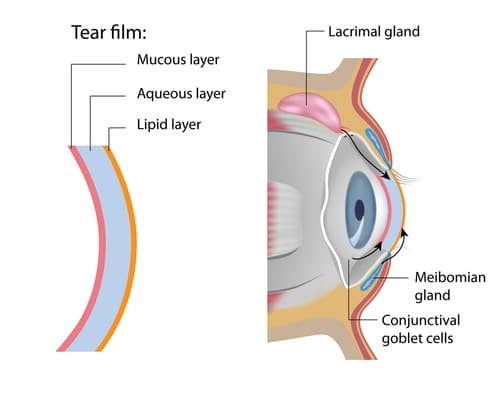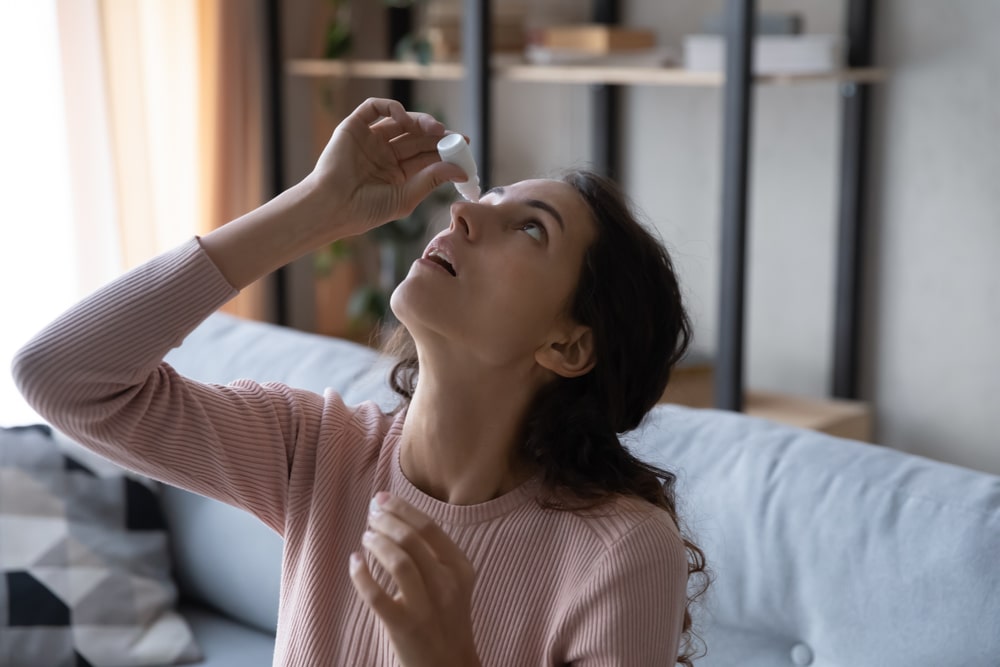Are your eyes dry, itchy, or irritated? It’s normal for your eyes to feel a little irritated or uncomfortable sometimes.
But when they frequently feel irritated, and the cause is unclear, it could be because they’re too dry. Dry eyes are very common and can even be a symptom of a chronic condition called dry eye syndrome. Keep reading to learn if you could be experiencing the most common symptoms of dry eyes!
What are Dry Eyes?
You may experience dry eyes if there’s an issue with your tear film. Your tear film comprises the tears that keep your eyes lubricated and are distributed over your eyes when you blink.
Dry eyes are caused either by an issue in tear distribution or the production of tears. You may not distribute enough tears due to not blinking enough or tears evaporating too quickly due to being in a dry environment.
However, these issues usually only cause temporarily dry eyes. Chronically dry eyes, like dry eye syndrome, are typically caused by inadequate tear production.

Your tears have three layers that contain different components:
- The inner layer is made of mucus
- The middle is made of water (also called aqueous)
- The outer layer is made of oil (also called lipids)
When your eyes don’t produce enough of one of the components, your tears cannot lubricate your eyes adequately. If you can no longer produce sufficient tears, this usually leads to dry eye syndrome.
Dry eye syndrome is extremely common, especially in older adults and women going through hormonal changes from pregnancy or menopause. It’s also often associated with inflammatory skin conditions like rosacea.
However, anyone can develop dry eye syndrome. If you’re unsure if you have dry eye syndrome, the only way to know if you have the eye condition is to see your eye doctor at Traverse City Eye for a diagnosis.
But before you can do that, it’s helpful to know if you have the most common symptoms of dry eye syndrome.
Inflammation
One of the primary symptoms of dry eyes is inflammation. Lack of moisture on the surface of the eyes makes them more prone to bacteria.
Bacteria cause irritation and inflammation, making your eyes appear red and the conjunctiva lining the eyelids appear puffy. Inflammation can also cause dry eyes, which is often the case if you have an inflammatory skin condition.
Inflammation of the eyelids can make it hard for the glands in your eye that produce oil to work, so your tears lack their outer protective layer and evaporate too quickly.

Burning and Stinging
Inflammation often makes your eyes feel like they’re burning or stinging. Experiencing burning or stinging occurs because your eyes are more sensitive when they lack moisture. Even bare air on your eyes can make your eyes sting.
Watering
Although it may seem counterintuitive, dry eyes can make eyes more watery. Watery eyes occur because dry eyes happen if you aren’t producing enough tears.
Your eyes produce reflexive tears to compensate for an inadequate tear film. However, reflexive tears usually won’t provide much relief as they often lack proper nutrients, just as your tear film doesn’t have enough components of the tear film.
Mucus Around the Eyes
Poor tear composition also often causes your eye to produce more of one component to compensate for the lacking component. Producing more components may lead to your tears containing more mucus.
When reflexive tears dry up around the eyes, they leave mucus behind, which can get stuck in the eyelashes.
Gritty Feeling In Your Eyes
When you have dry eyes, it often feels like there’s something in your eye, even if there’s nothing there. Experiencing this feeling is because your eyes are much more sensitive when you don’t have a sufficient tear film. You may find that your eyes often feel gritty for no reason when you have dry eye syndrome.
Itching

Eye irritation can make you want to rub your eyes more, especially when you feel like there’s something in your eyes. Your eyes may feel slightly itchy when you have dry eyes, but itchiness isn’t usually the main symptom.
However, if you have eye allergies, you’re likely to have very itchy eyes, so you’ll want to rub them more. However, rubbing your eyes will only make them more irritated and can also damage them.
It’s important to recognize the difference between eye allergies and dry eyes. Remember that dry eyes make your eyes burn more than itch.
Of course, it is possible to have both eye allergies and dry eyes. In such cases, the conditions feed into each other and make both symptoms worse.
If you notice that you’re experiencing eye irritation often, it’s time to see your eye doctor, especially if you can’t pinpoint what’s causing the irritation.
Difficulty Wearing Contact Lenses
Dry eyes make it more challenging to wear contact lenses. Wearing contacts will make your eyes more dry. However, if your eyes are healthy, you can lessen how dry your eyes get by using contact lens solution.
But when you have dry eyes, solution alone often isn’t enough to compensate for this drying effect. This can make wearing contact lenses unbearable.
Diagnosis and Treatment
If you’re experiencing any of these symptoms, see your eye doctor as soon as possible to receive a diagnosis. If you’re diagnosed with dry eye syndrome, your ophthalmologist can recommend appropriate treatment.
This may include in-office treatments to help reduce your dry eye symptoms. These may include prescribing Restasis to increase your eye’s ability to produce tears, Xiidra to improve inflammation, using Prokera to heal your cornea and improve dry eye symptoms, or, in the case of more severe dry eye symptoms, using a Biotissue Amniograft for patients with conjunctivochalasis to help hold tears in the eye.
Treatment is essential as leaving dry eye syndrome untreated can cause several issues with your eyes or eventually lead to vision loss. Which treatments your eye doctor recommends will depend on the severity of your symptoms and the root cause of the eye condition.
Are you ready to treat your dry eyes? Take the first step by requesting your appointment at Traverse City Eye in Traverse City, MI, now!
